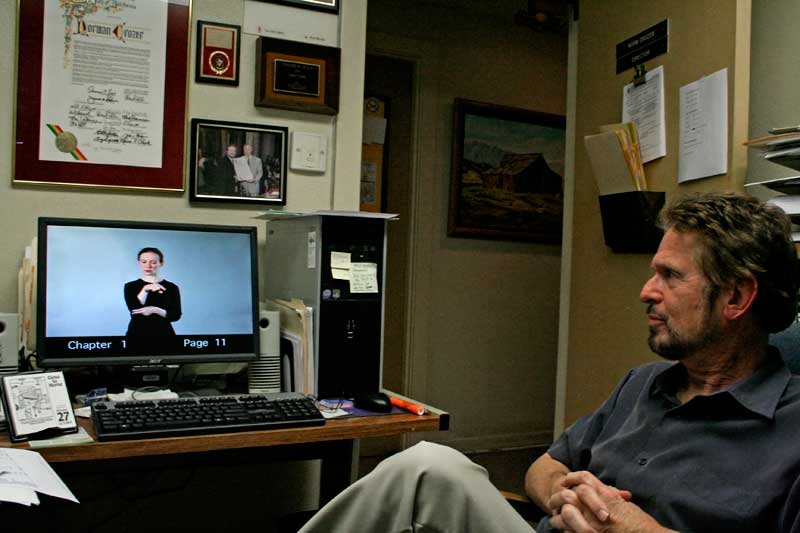Melissa Meek, Spring 2009 Features Editor
The second history textbook translated into American Sign Language at Pierce College is almost finished, paving the way for the completion of a federally-funded project to help deaf students by translating textbooks into ASL.
The idea was started by Norm Crozer, director of special services, and has been in progress for more than two years.
“I thought it would be a good idea to have books for the deaf as they have books for the blind,” Crozer said. “A lot of deaf students have a language disability; they never had a way to get the material before and I had the idea to take the books, take a translator and translate it.”
The idea took off when Crozer teamed up with Mark Pracher, grants coordinator, to write the grant and budget and apply for the Fund for the Improvement of Postsecondary Education (FIPSE). They received the grant within three months of applying for it.
“Usually, only huge universities get this grant. We were shocked to receive more than $600,000 and three years through the Department of Education to complete this,” Crozer said.
Pierce teamed up with Ohlone College, Santa Rosa Junior College, El Camino College and San Diego Mesa College to do a series of 10 videos. Each video will represent a popular and well-used book from one of 10 surveys and introduction courses required for general education.
“The original plan was to film the videos, edit them and burn them on to DVDs, but we discovered each book would use about 10 to 11 DVDs and it would take too much time and money to reproduce them and ship them out,” Crozer said.
He said the videos feature two of Pierce’s interpreters, with a third scheduled to start soon.
“The first video is finished and the second is far into it. They record new pages every Friday and they worked extensively over the summer,” Pracher said. “It’s a long process to record these books.”
Once finished, the videos will be available on the Pierce Web site. They will also be added to iUniversity, an online storage area owned by Apple for colleges to host materials for streaming or downloading to iPods for on-the-go learning.
“It will definitely impact how deaf students learn. How they speak is completely different and while it’s possible to sign perfect English, that’s not how ASL really works,” said Reina Rivera, an ASL student.
According to Crozer, the other colleges’ progress is unknown at this time. As they enter the third year of the grant, Crozer said they may have to apply for an extension.
“I don’t know if we can finish in the final year, but the extension is an easy thing to do. We just need more time, not more money,” Crozer said.
Pracher agreed.
“The government accepts that a proposal is an idea and that there will be changes or delays in a project like this,” Pracher said.
Though the finish date for the project is unknown at this time, the process of translating materials into ASL will not be over when the textbook translation is complete, as Crozer said there is another set of videos in the making.
“We want to do a separate set of short videos on study skills. These will focus on how to take notes and use the textbook videos effectively,” Crozer said.

Norm Crozer talks about plans Monday to make American Sign Language visual textbooks available to students through the Pierce Web site, hopefully by the spring of 2009. ()
